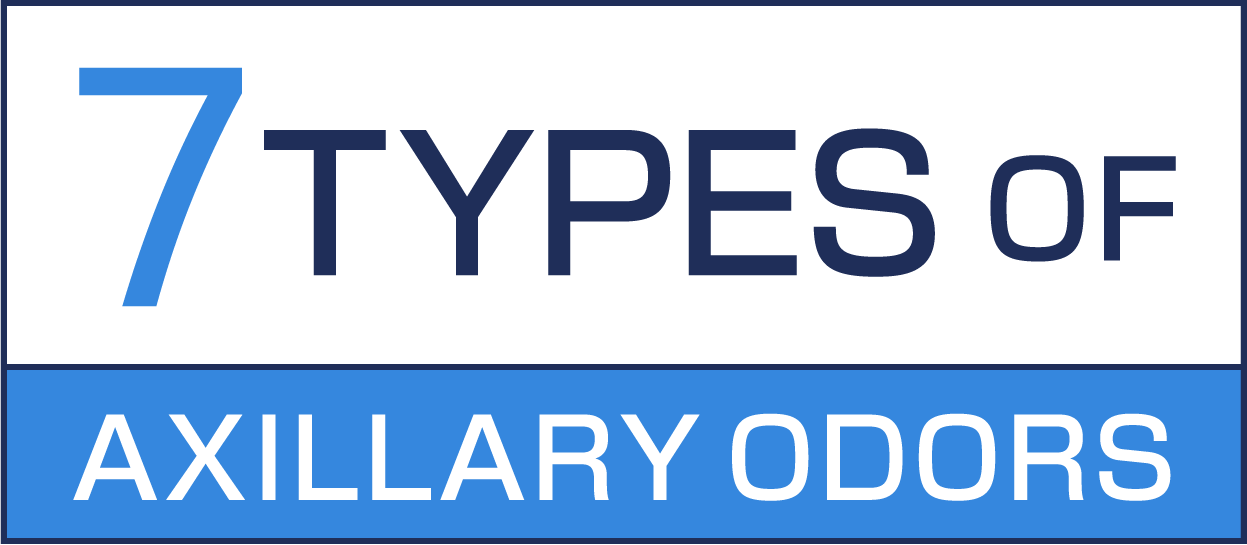R&D Information
Pick Up Contents
of "Axillary Odor" in Japanese Men
Body odor is produced from every part of the human body,
but among these areas the axillae in particular produce a large amount of sweat.
This is an area that many men are concerned about odor the most.
In 2006, Mandom conducted several studies and gained an array of knowledge regarding body odor in men.
In this publication we will introduce some of our discoveries regarding axillary odor.
Body odor is produced from every part of the human body,
but among these areas the axillae in particular produce a large amount of sweat.
This is an area that many men are concerned about odor the most.
In 2006, Mandom conducted several studies and gained an array of knowledge regarding body odor in men.
In this publication we will introduce some of our discoveries regarding axillary odor.
7 Types of Axillary Odor Determined Through Olfactory Measurements
by Mandom Researchers
-
M type
Milky -
A type
Acid -
C type
Curry-like/
Spicy -
K type
Moldy -
E type
Meaty -
W type
Watery -
F type
Ferric(iron-like) -
Other
Other
Mandom researchers used their noses to directly smell the armpits of subjects and make evaluations through olfactory measurements. Their results showed that there are seven types of axillary odors in Japanese people. (*1)
Although "axillary odor" can be summed up in two words, there are actually various types of axillary odors.
We investigated deeper to find out which type was more prevalent, what kind of features each odor had, and how strong each odor smelled.
Note: Every person's axillary odor is not just one type of the seven types listed here, but rather consists of a mix of several different types.
 The Reality of Men's Axillary Odor
The Reality of Men's Axillary Odor
Discovered by Directly Smelling Armpits
1
Approximately 40% Are "Milky."
Relatively Large Percentages of "Acid" and
"Curry-Like/Spicy" Odor Also Found.
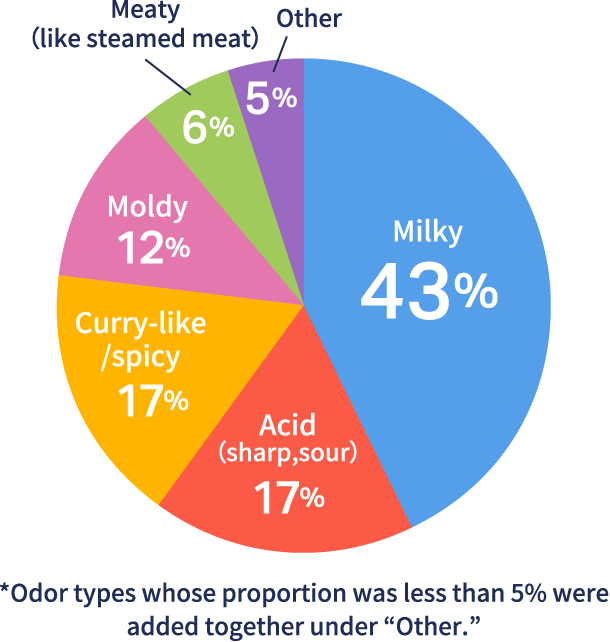
Upon investigating the ratio of each odor type, Mandom researchers discovered that around 80% of men's axillary odors was comprised of three types of odors. Namely, these were "milky" odor (M-type) which was the most prevalent, "acid" odor (A-type) and "curry-like/spicy" odor (C-type).
(The proportion of each type, including the axillary odor of subjects, was evaluated in increments of 10% so the total would equal 100%) (*2)
2
The Strength of Odor Differed for Each
Type of Odor
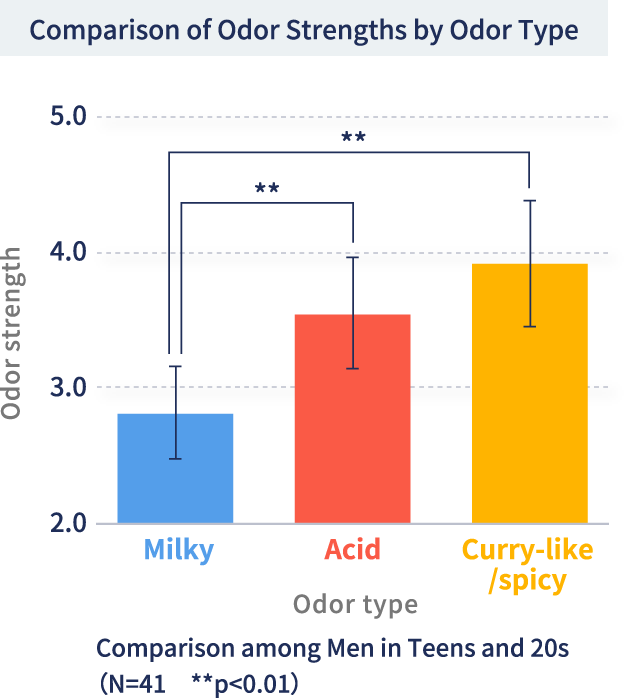
We performed a sensory evaluation on 41 males in their teens and 20s who have all M-type, A-type, and C-type odors. This was done to compare the strength of each odor ("milky" (M-type), "acid" (A-type), and "curry-like/spicy" (C-type)) which are the main axillary odor types possessed by Japanese men. As a result, we found that the strength of C-type and A-type odors were very strong, and that the odor of men who mainly possessed the C-type axillary odor was particularly strong compared to men who mainly possessed another type of axillary odor. (*1)
3 Odors Change with Age
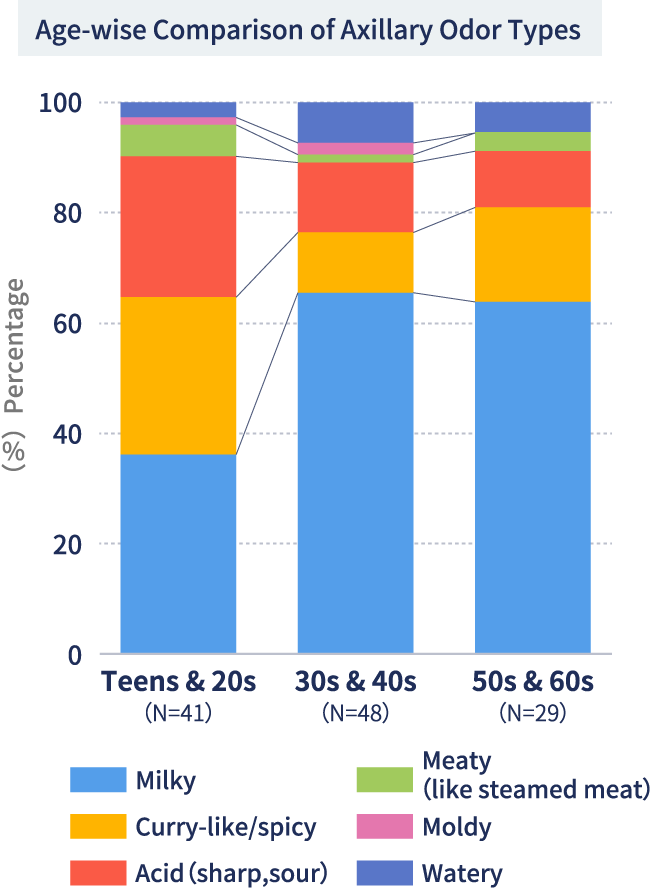
We examined each type of axillary odor on subjects ranging from age 10 to 69. After comparing the results for each generation, we found that many men in their teens and 20s had "acid" (A-type) and "curry-like/spicy" (C-type) odors. On the other hand, the percentage of A-type and C-type odors decreased in men in their 30s and older, and because of this we saw that there was a tendency for the percentage of the "milky" (M-type) odor to increase. (*1)
4 Axillary Odor was Strongest in Men in Their Teens and 20s
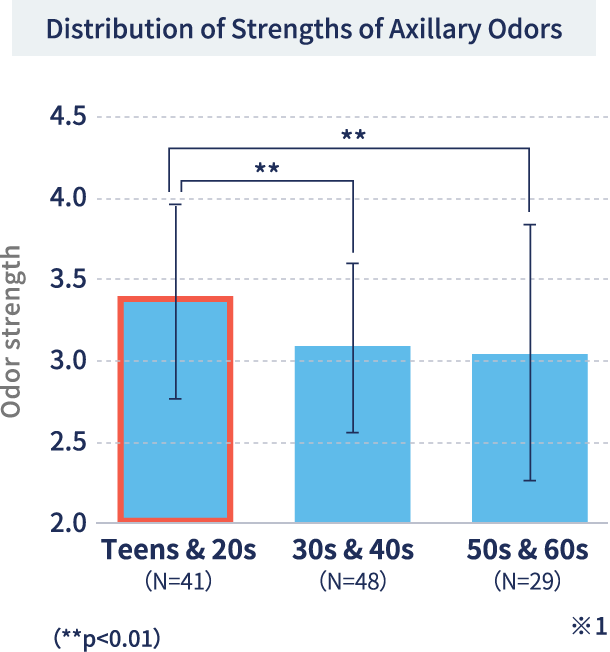
After investigating the strength of axillary odors by generation, we found that men in their teens and 20s tended to have the strongest odor, while the strength of axillary odor in men in their 30s or older tended to decrease.
In short, we speculate that the strength of axillary odors in men in their teens and 20s is affected according to how prevalent the strong "milky" (A-type) axillary odors and "curry-like/spicy" (C-type) odors are. However, it can be said that although there are some elderly subjects with strong axillary odors, there are still large differences among individuals in the same age category. (*1)
5 Over 90% of Men Have an Odor That is Noticeable by Others
After evaluating the axillary odor strength of test subjects aged 10 to 69 by using a 6-point scale, we found that over 30% had a strong axillary odor of four or above, and if that figure was combined with the percentage of men who had an axillary odor strength of three or above, we saw that over 90% of the men had an odor noticeable by others. (*1)
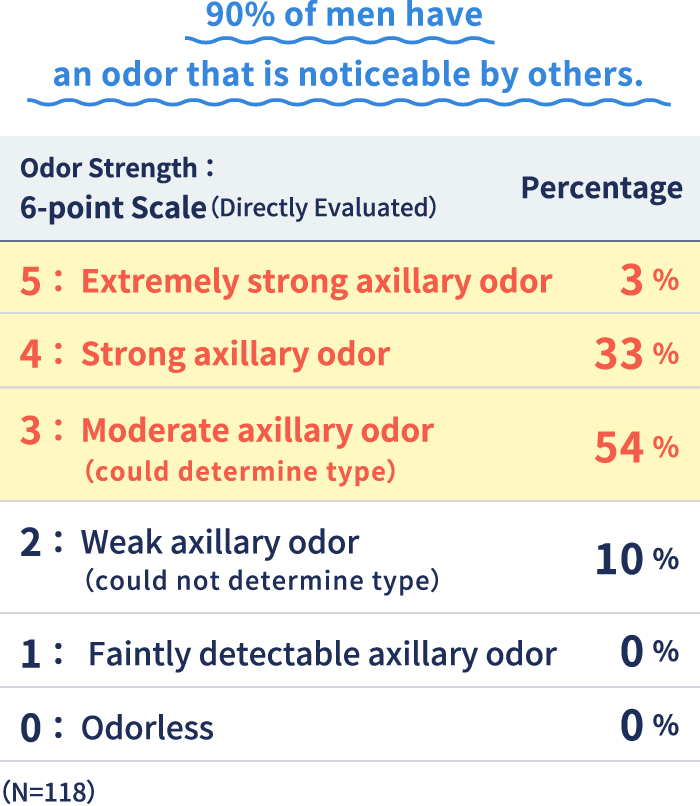
-
- Image of odor
strength 5 - Lingering odor
is noticeable

- Image of odor
-
- Image of odor
strength 4 - Odor is noticeable
by others
when you pass them

- Image of odor
-
- Image of odor
strength 3 - Odor is noticeable by others
when in close quarters
such as in an elevator
or a crowded train

- Image of odor
Tough odor researchers are
analyzing data in the front lines!
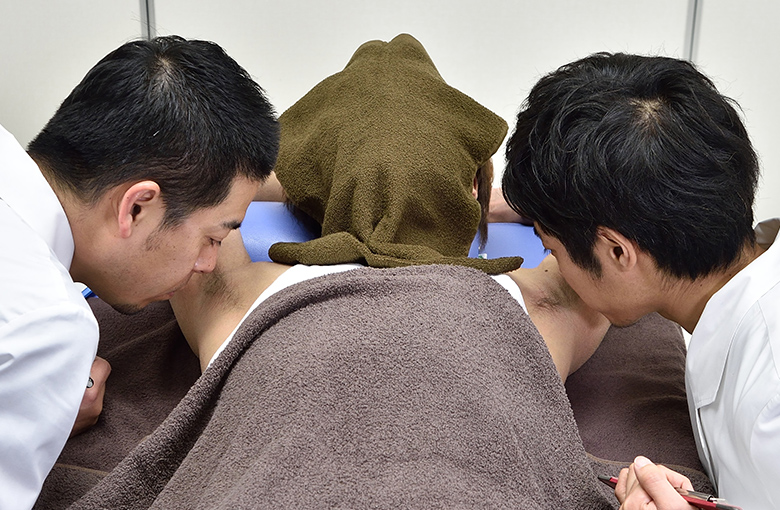
Body Odor Research
that Utilizes the Human Sense of Smell
Body odor research is tough work. Since machines cannot distinguish what kind of odors humans actually smell, such as "spicy" or "acid," humans need to use their sense of smell to make judgements. Mandom assembles a team of researchers, mainly consisting of nationally qualified "Olfactory Measurement Operators" who have received special training, who smell various parts of the body such as the armpits and do a profile of each area. These researchers smell around 200 test subjects each year and need to employ a high level of concentration to pick out faint scents within odors.
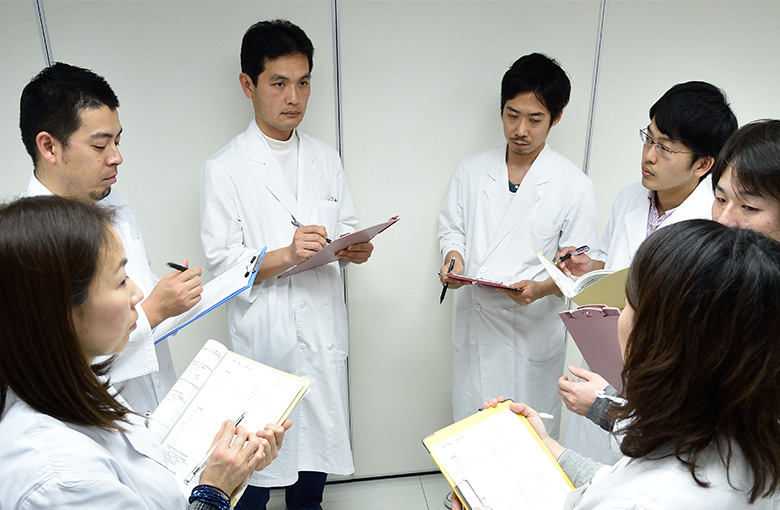
Original Index &
Cohesiveness of Research Team
Mandom conducts odor measurements and evaluations using an original index it created which consists of 13 odor evaluation items from clinical trial data.
The research team increases the accuracy of the odor judgements they make by splitting into teams and having several researchers judge the odor of one test subject, then comprehensively evaluating the results.
 We uncovered the truth about the axillary odor of Japanese men,but
We uncovered the truth about the axillary odor of Japanese men,but
why does axillary odor (sweaty odor) occur in the first place?
Axillary Odor (Sweaty Odor) Production Mechanism
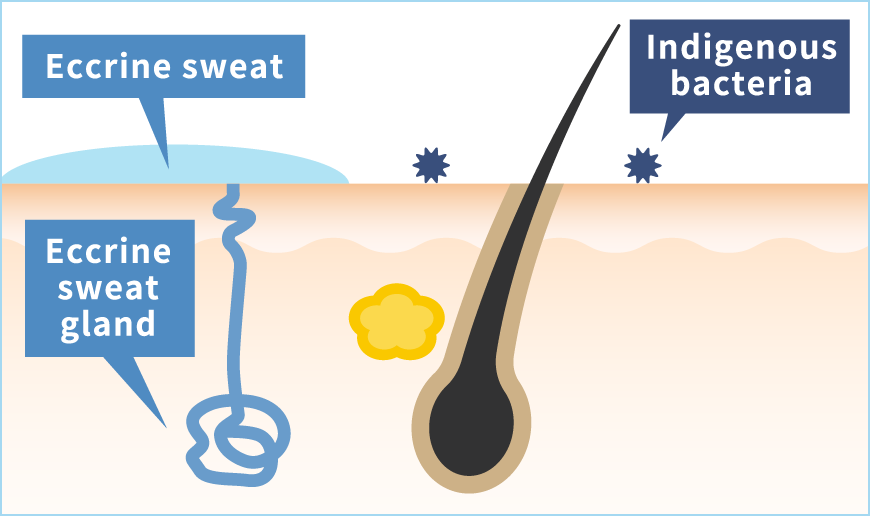
- 1
- Sweat is secreted from eccrine sweat gland.
Eccrine sweat glands are distributed
throughout the entire body.
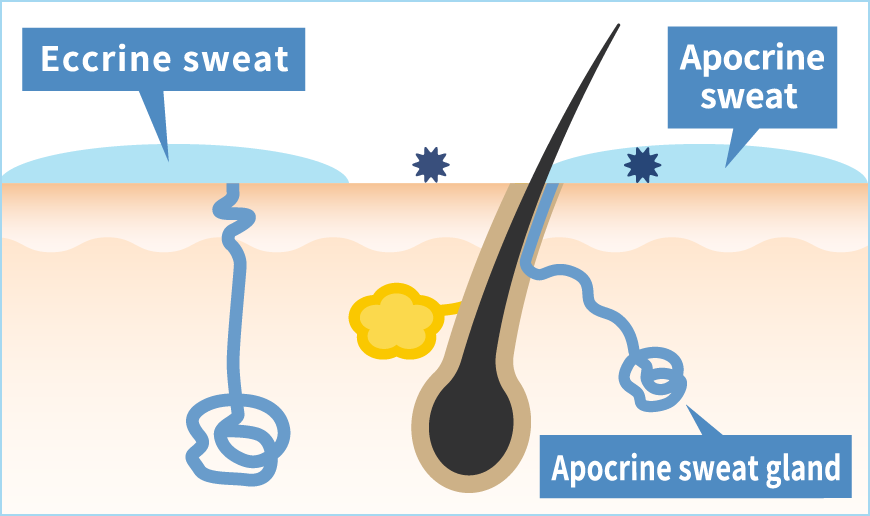
- 2
- Sweat is secreted from apocrine sweat gland.
Apocrine sweat glands are distributed
throughout a small fraction of the human body
such as in the armpits and areola.
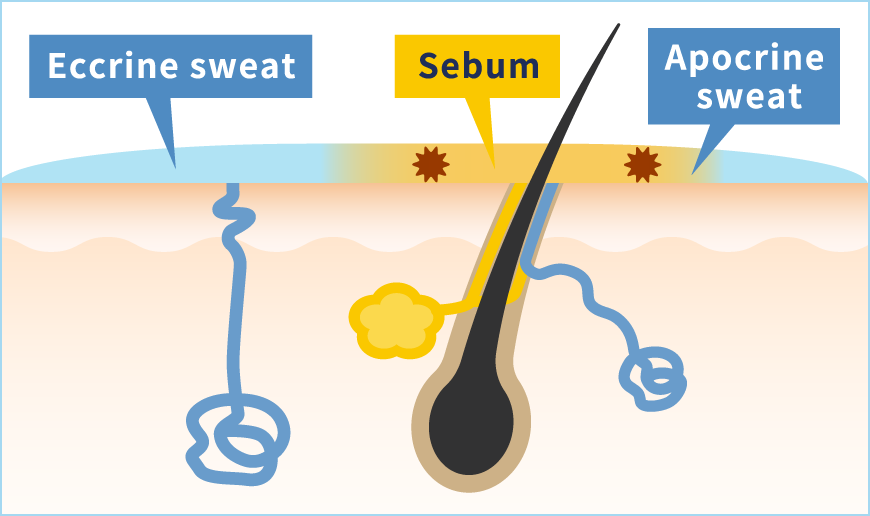
- 3
- Sebum is secreted from the sebaceous gland
and mixes with sweat.
Both the sweat and sebum are odorless.
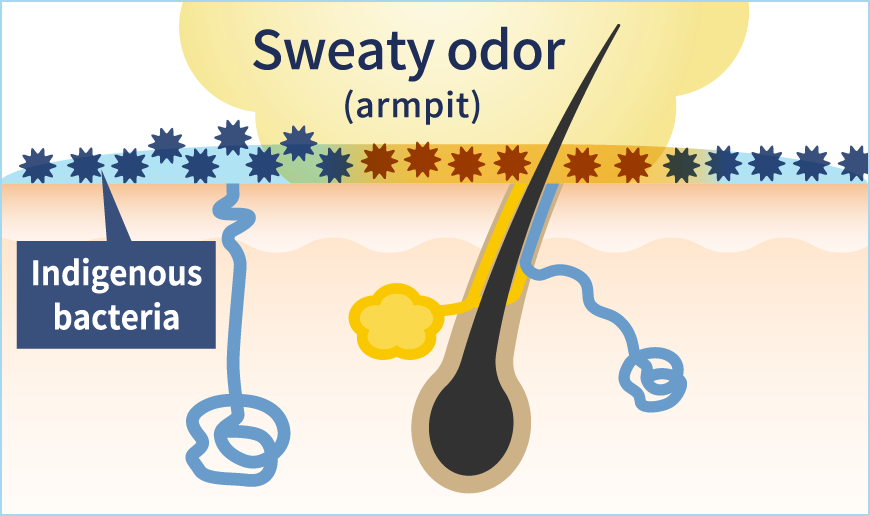
- 4
- Indigenous bacteria on the skin metabolize
and decompose sweat and sebum as food, and multiply.
Odor comes from waste matter after sweat and sebum are metabolized and decomposed by bacteria.
Three points to note when
dealing with axillary odor.
Important points to remember
- 1
- Reduce perspiration which
is the source of the odor
- 2
- Sterilize the bacteria which
convert sweat into odor
- 3
- Wipe away sweat & odor that
has been produced

Before sweating

We recommend a deodorant that is highly adhesive, reduces perspiration and sterilizes bacteria, and deodorizes.
After sweating/odor is produced

Using a body paper to wipe off sweat and odor is effective.
Afterwards, using a roll on deodorant, etc. will help improve odor care.
*1
- Survey Subjects
- 118 healthy Japanese men aged 18 to 68 who have used deodorants before
- Survey Period
- Aug. 18-Aug. 25, 2006
- Survey Conditions
- Subjects washed their armpits with unscented soap and wore an odorless T-shirt. After 24 hours, Mandom researchers performed a direct sensory evaluation of their axillary odor in both armpits from a distance of 2-3 cm.
*2
- Survey Subjects
- 87 Japanese men in their 20s and 40s
- Survey Period
- July-August 2014, July-August 2015
- Survey Conditions
- Subjects washed their armpits with unscented soap and wore an odorless T-shirt. After 24 hours, Mandom researchers performed a direct sensory evaluation of their axillary odor in both armpits from a distance of 2-3 cm.
